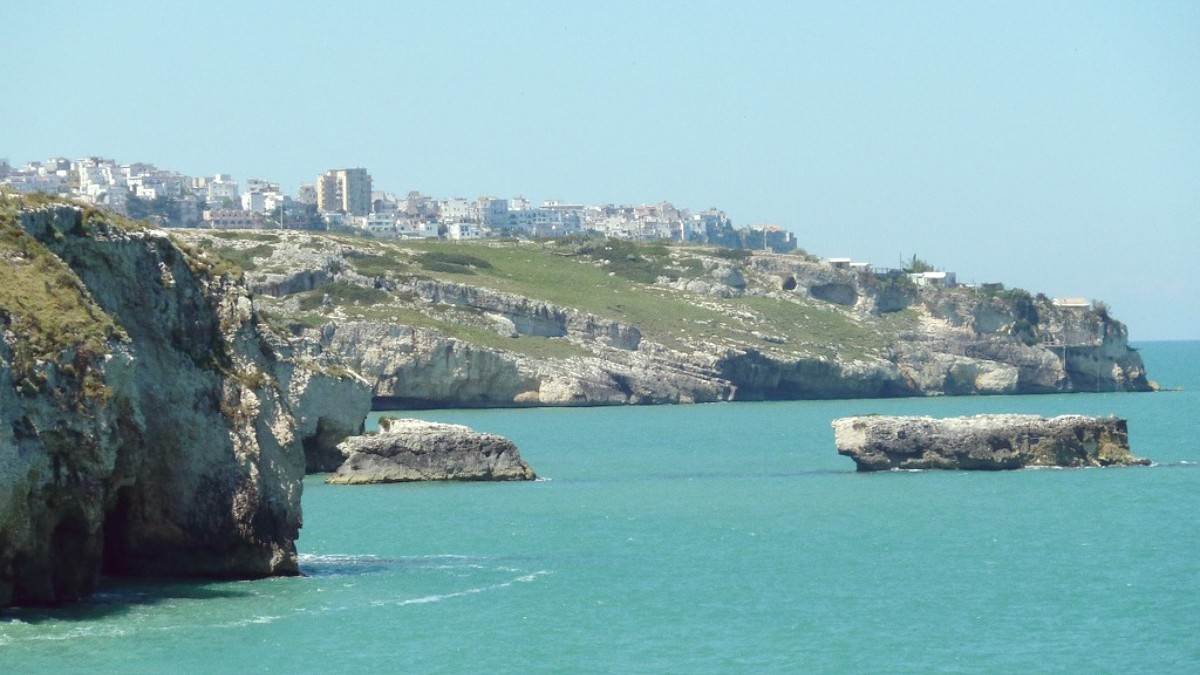
Puglia, Italy
Vieste is more than scenic backdrops. It presents a chance to experience life at a different pace. Visitors find themselves drawn into a relaxed atmosphere, where the aroma of fresh seafood mixes with the scent of pine trees and sea salt. The town serves as a gateway to the broader Gargano National Park, a protected area boasting ancient forests, coastal trails, and secluded beaches. Whether a peaceful retreat, an outdoor adventure, or a connection with Italian culture, Vieste delivers a varied and rich experience.
The iconic Pizzomunno monolith, a towering limestone stack, is a silent guardian on Vieste's main beach. This feature captivates attention and sets a tone for the town's unique character. Discover small artisan shops, traditional eateries, and cafes tucked into unexpected corners.
Local people welcome visitors, sharing their love for their land through hospitality and cuisine. Spend mornings on a boat tour exploring hidden sea caves, afternoons relaxing on a sun-drenched beach, and evenings savoring fresh Puglian dishes. The town, a place for discovery, for slowing down, and for enjoying the simple pleasures of a coastal Italian summer or a peaceful shoulder-season retreat. It invites lasting memories, against a backdrop of striking natural beauty and historical depth.
Vieste occupies a prominent location on the easternmost point of the Gargano Promontory, a spur often called the "spur of Italy" due to its map shape. This promontory forms a distinct geographical feature of Puglia, separating the Adriatic Sea from the flatter, agricultural plains to the west. Vieste's location defines itself by its two bays, Marina Piccola and Pizzomunno, which frame its historic center. The town itself sits on a limestone peninsula, rising sharply from the sea. This forms its characteristic tiered structure, with the old town perched at the highest point.
The coastline around Vieste is a study in contrasts. To the north, wide, sandy beaches stretch for kilometers, with calm, shallow waters. These areas developed with resorts and camping villages, welcoming families and those seeking beach relaxation. South of the town, the coastline transforms into a rugged expanse of high limestone cliffs, dramatic sea stacks (known as faraglioni), and numerous sea caves. Erosion by wind and waves sculpted these formations over millennia, creating a landscape that draws visitors for boat tours and exploration. The famous Arco di San Felice, a natural rock arch, is a prime example of this geological artistry.
Inland from Vieste, the terrain shifts to rolling hills and dense forests.
This UNESCO World Heritage-listed primeval beech forest, cooler and shaded, contrasts with the sunny coast.
The park also includes Lake Lesina and Lake Varano, important for migratory birds.
The winding SS89 coastal road connects to other Gargano towns.
Sea breezes temper summer heat; mild winters due to maritime influence.
The SS89 coastal road connects it to other Gargano towns like Peschici and Mattinata. This road presents scenic views. The town's position defines its appeal as a destination for both beachgoers and nature lovers.
North of Vieste, wide, sandy beaches extend for kilometers. These areas, with calm, shallow waters, developed with resorts and camping villages, catering to families and those seeking beach relaxation.
South of the town, the coastline transforms into a rugged expanse of high limestone cliffs, dramatic sea stacks, and numerous sea caves, including the famous Arco di San Felice.
The challenging terrain shaped Vieste's history, establishing it as a natural harbor and a point of defense.
Vieste's history extends to ancient times, with human settlement evidence dating to the Paleolithic era. Its naturally defensible position on a promontory made it an attractive site for early communities. The town experienced periods of Greek and Roman influence, serving as a minor port in Roman times. Archaeological finds from this era, including a necropolis at La Salata, offer glimpses into its early Christian past.
During the Middle Ages, Vieste gained prominence. It became a bishopric and developed into a fortified town under Byzantine rule. Its strategic location on the Adriatic made it a target for various invaders and a hub for maritime trade. The Normans and later the Swabians left their architectural mark, most notably with the Swabian Castle. Emperor Frederick II, known for his love of Puglia, reinforced the castle in the 13th century, recognizing Vieste's prominence in his southern Italian kingdom. The castle's imposing structure, perched high above the sea, is a testament to this period of military and political significance.
A testament to medieval military strength, reinforced by Emperor Frederick II.
Features ancient design elements, though rebuilt over time.
A solemn memorial to the 1554 Ottoman sack of the town.
Over subsequent centuries, Vieste remained a fishing and agricultural community, its economy tied to the sea and the land. Its relative isolation on the Gargano peninsula preserved much of its unique character and traditions. The narrow, winding alleys of Vieste Vecchia, the old town, reflect its medieval layout, largely untouched by modern urban planning.
Vieste Vecchia: a maze of narrow, cobbled streets, white houses, and glimpses of the sea.
Spiaggia del Pizzomunno and Spiaggia di San Lorenzo, with soft sand and clear waters, mark the coast.
Diverse landscapes from Umbra Forest to coastal trails await exploration.
A tall limestone stack, an unique landmark directly on the beach, captivating with its striking presence.
South of the town, dramatic cliffs, natural arches like Arco di San Felice, and magnificent sea caves await.
An UNESCO World Heritage site, ancient beech forests contrast with the sunny coast, perfect for nature immersion.